

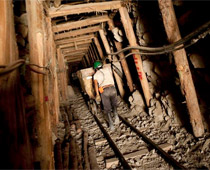
Read more:
The pilot communities of artisanal fair trade gold miners
Since its inception, the Alliance for Responsible Mining (ARM) has helped different mining communities in several South American countries, relying on local NGOs that have provided important work. Veritable pilot projects for the implementation of fair trade gold standards, it is these mining communities that will witness the emergence in 2010 of the first certified producers of fair trade gold.
Cotapata mining cooperative
Bolivia
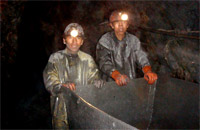 Founded in 1991 at an altitude of 4,500 meters (nearly 15,000 feet) in the heart of Cotapata National Park, the Cotapata mining cooperative currently consists of 88 workers, including 10 women.
Founded in 1991 at an altitude of 4,500 meters (nearly 15,000 feet) in the heart of Cotapata National Park, the Cotapata mining cooperative currently consists of 88 workers, including 10 women.
The Cotapata mining cooperative produces an average of 2.5 kilos of gold per month, from an underground hard rock mine.
In addition to being highly organized, the Cotapata mining cooperative is recognized as being one of the few gold-producing cooperatives to work with a closed-loop system for mercury recovery and to provide its miners with complete security. Located as it is in the heart of a national park, the cooperative has been pursuing responsible mining practices for several years now.
Macdesa mining company
Peru
(currently undergoing fair trade certification)
 Located in the village of Cuatro Horas, in the Caravelí province of southern Peru, the Macdesa mining company was founded in 2004 through the federation of 478 artisanal miners. Today Macdesa has 388 shareholders, divided into four groups of independent producers. In addition, Macdesa has partnered with other groups of miners, and collaborates with a group of female miners. In all, more than 550 families live off of the Macdesa mine.
Located in the village of Cuatro Horas, in the Caravelí province of southern Peru, the Macdesa mining company was founded in 2004 through the federation of 478 artisanal miners. Today Macdesa has 388 shareholders, divided into four groups of independent producers. In addition, Macdesa has partnered with other groups of miners, and collaborates with a group of female miners. In all, more than 550 families live off of the Macdesa mine.
The Macdesa mining company operates a hard rock mine and processes about 400 metric tons of ore per month.
Rising incomes have played a major role in local development, resulting in the completion of various major infrastructure and social projects: development of an electrical grid and a water supply network; establishment of medical services and procurement of supplies of medicine; facilities for elementary schools, athletic facilities, waste collection, etc.
Sociedad de Trabajadores Mineros
Peru
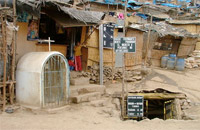 Sociedad de Trabajadores Mineros (the "society of mine workers"), or SOTRAMI, operates a mine next to the village of Santa Filomena, in central Peru's Atacama desert. SOTRAMI was created in 1989 by artisanal miners who sought, at the time, to obtain a mining concession. Today SOTRAMI is owned by 166 co-shareholders and operates a mining concession of approximately 1,000 hectares (around 2,500 acres).
Sociedad de Trabajadores Mineros (the "society of mine workers"), or SOTRAMI, operates a mine next to the village of Santa Filomena, in central Peru's Atacama desert. SOTRAMI was created in 1989 by artisanal miners who sought, at the time, to obtain a mining concession. Today SOTRAMI is owned by 166 co-shareholders and operates a mining concession of approximately 1,000 hectares (around 2,500 acres).
SOTRAMI operates an underground hard rock mine and processes an average of 700 metric tons of primary ore per month and 200 metric tons of residual waste. Currently, the company is working on a more effective processing technology: cyanide leaching in agitated tanks, in order to increase its daily ore production capacity to 30 metric tons.
Comunidad Aurifera Relave
Peru
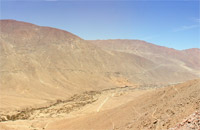 Comunidad Aurifera Relave (Relave gold community), or Aurelsa, is located in the Parinacochas province of southern Peru's Ayacucho region. Aurelsa was created in 1997 by 86 individuals, including 78 men and 8 women, who founded the private company to obtain mining rights. Today Aurelsa operates seven mines under mining concessions of approximately 1,000 hectares (around 2,500 acres).
Comunidad Aurifera Relave (Relave gold community), or Aurelsa, is located in the Parinacochas province of southern Peru's Ayacucho region. Aurelsa was created in 1997 by 86 individuals, including 78 men and 8 women, who founded the private company to obtain mining rights. Today Aurelsa operates seven mines under mining concessions of approximately 1,000 hectares (around 2,500 acres).
Three groups of affiliated workers and various groups of independent miners operate seven underground hard rock mines. They process approximately 180 metric tons of ore per month. The mined ore is processed in the company's own factory using a cyanide leaching method.
The main challenges facing Aurelsa's miners today are improving their processing methods - with notably the setting up of a gold assaying laboratory - and building their own plant for the elution of gold-laden carbon. The first load of Aurelsa-produced gold was shipped to France in October 2008.
Les Pallaqueras
"New Hope" Peru association for women who sort ore
Peru
(currently undergoing fair trade certification)
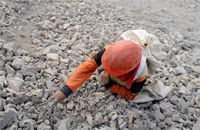 A non-profit association founded in 2003, Pallaqueras (literally "women who sort ore") has nearly 180 members (up from an initial 40), all of whom are women, in the town of Santa Filomena in central Peru's Atacama desert. A member of the National Association of Women in the Peruvian Artisanal Mining Sector, the association, christened "New Hope," is working together with SOTRAMI on the collection of valuable minerals and sorting of mining waste. Once sold to SOTRAMI, the ore collected can generate additional income for these women.
A non-profit association founded in 2003, Pallaqueras (literally "women who sort ore") has nearly 180 members (up from an initial 40), all of whom are women, in the town of Santa Filomena in central Peru's Atacama desert. A member of the National Association of Women in the Peruvian Artisanal Mining Sector, the association, christened "New Hope," is working together with SOTRAMI on the collection of valuable minerals and sorting of mining waste. Once sold to SOTRAMI, the ore collected can generate additional income for these women.
The Santa Filomena women's association shares many social values with those espoused by fair trade standards and hopes, as such, to obtain the fair trade gold certification of its collection work.
Cuatro Horas association of ore sorters
Peru
(currently undergoing fair trade certification)
 Established in 2004, the association of women who sort ore is located in the city of Cuatro Horas, in southern Peru's Caravelí province. A non-profit association and member of the National Association of Women in the Peruvian Artisanal Mining Sector, this community is composed of approximately 150 women who collect and sort the waste generated by the Macdesa mining company.
Established in 2004, the association of women who sort ore is located in the city of Cuatro Horas, in southern Peru's Caravelí province. A non-profit association and member of the National Association of Women in the Peruvian Artisanal Mining Sector, this community is composed of approximately 150 women who collect and sort the waste generated by the Macdesa mining company.
Bella Rica mining cooperative
Ecuador
(currently undergoing fair trade certification)
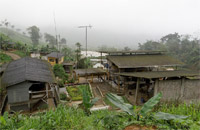 Founded in 1993, the Bella Rica mining cooperative is located in the canton of Ponce Enriquez, in southern Ecuador's Azuay province. The cooperative was established under the World Bank program for the development of artisanal and small-scale mining (ASM) to fight the uncontrolled growth of mining in the region. The cooperative has a large (1,422 hectares, around 3,500 acres) mining concession. Of its 141 members, 118 are men and 33 are women, divided into 56 mining companies.
Founded in 1993, the Bella Rica mining cooperative is located in the canton of Ponce Enriquez, in southern Ecuador's Azuay province. The cooperative was established under the World Bank program for the development of artisanal and small-scale mining (ASM) to fight the uncontrolled growth of mining in the region. The cooperative has a large (1,422 hectares, around 3,500 acres) mining concession. Of its 141 members, 118 are men and 33 are women, divided into 56 mining companies.
One of these companies, Comimach, operates the underground mines and processes an average of 300 metric tons of ore per month.
Comimach is currently one of the mining companies farthest along with its fair trade gold certification. In June 2009 the company hosted and partially funded the pre-certification workshop conducted by FLO for all of ARM's pilot projects.
Llanada mining cooperative
Colombia
(currently undergoing fair trade certification)
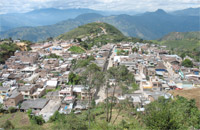 The La Llanada mining cooperative, or Coodmilla, is located in the town of La Llanada, in southern Colombia's Narino region. The cooperative was created in 1977 from the legacy given to former mine workers by the American company that operated the El-Canada and de la Palmera mines in the 1970's. The cooperative currently employs 167 people, enabling 372 families (with a total of 1,860 members) to live off of mining.
The La Llanada mining cooperative, or Coodmilla, is located in the town of La Llanada, in southern Colombia's Narino region. The cooperative was created in 1977 from the legacy given to former mine workers by the American company that operated the El-Canada and de la Palmera mines in the 1970's. The cooperative currently employs 167 people, enabling 372 families (with a total of 1,860 members) to live off of mining.
A gravimetric method is employed to recover the gold, without the use of cyanide or mercury.
The fair trade gold certification process will require additional investment, as well as new efforts in terms of collective savings and the employment of women.
Cumbitara artisanal mining association
Colombia
(currently undergoing fair trade certification)
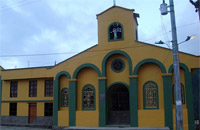 The Cumbitara artisanal mining association is located in the northwest of southern Colombia's Nariño department. A non-profit association, Cumbitara was created in 1992 by a cooperative of artisanal miners who wanted to formalize their activities in order to gain access to explosives and state aid. Cumbitara currently has 25 members, five of whom are women.
The Cumbitara artisanal mining association is located in the northwest of southern Colombia's Nariño department. A non-profit association, Cumbitara was created in 1992 by a cooperative of artisanal miners who wanted to formalize their activities in order to gain access to explosives and state aid. Cumbitara currently has 25 members, five of whom are women.
Today, 630 miners work in the various underground mines in Cumbitara, allowing about 100 metric tons of ore to be processed per month.
The immediate key fair trade gold-related issues for the Cumbitara association are environmental in nature, including wastewater treatment and waste and groundwater management. As such, an experiment is underway to allow for the resale of residual sand, which can be used as a building material.

Last post of Patrick Schein's blog
Warning: DOMDocument::load(): Extra content at the end of the document in http://www.patrickschein.com/blog-en/?feed=rss, line: 2 in /home/goldbygold/domains/patrickschein.com/public_html/us/news.php on line 28
Fatal error: Uncaught Error: Call to a member function getElementsByTagName() on null in /home/goldbygold/domains/patrickschein.com/public_html/us/news.php:32 Stack trace: #0 /home/goldbygold/domains/patrickschein.com/public_html/us/mining-communities.php(187): include() #1 {main} thrown in /home/goldbygold/domains/patrickschein.com/public_html/us/news.php on line 32